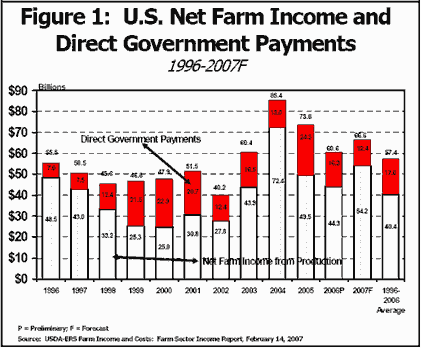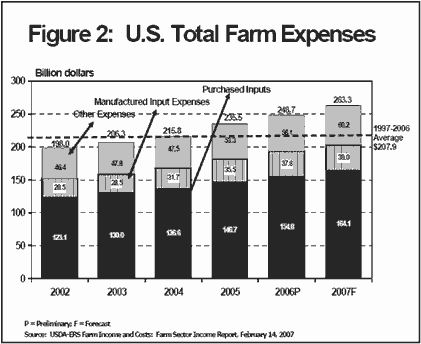AG-ECO NEWS
Vol. 23, Issue 8, March 21, 2007
Jose G. Peña
Extension Economist-Management
Initial Forecast of U.S. Net Farm Income Up $6 Billion
Consumers and Farmers Financing Attempt at Energy Independence
Production Costs Up $9.3 Billion
USDA’s initial, February 14, 2007, forecast of U.S. net farm income for 2007 at $66.6 billion is up $6 billion (9.9%) from $60.6 billion in net income in 2006 and $9 billion above the 10-year average of $57.4 billion. (See Figure 1). 
Livestock and especially grain markets have improved and the outlook appears good. Ethanol production is the single most significant activity affecting agricultural production. U.S. interest in renewable fuels has boomed in the last year and a half. Price bids for corn have almost doubled since last year and the outlook appears good as demand continues to increase. The improvement in the corn market has had a positive impact in most grain markets. It appears that corn prices will continue to improve as more ethanol plants become operational and world demand for grains continues to increase.
Consumers Financing Energy Independence
While prices for grains have increased substantially, it appears clear that consumers are sharing the costs of this recent move towards energy independence. Most consumers have noted a recent sharp increase in food prices. While we consume only a small amount of corn directly in the form of cereal, corn chips, etc. corn forms the basis of our food. Corn constitutes the primary feed source for most of the food we eat, i.e., beef, poultry, pork, lambs, fish, etc. and even pet food. High fructose corn syrup is the principle sweetener for almost everything we eat or drink, from soft drinks to chewing gum.
The Department of Labor’s (DOL), mid-March, Crude Foodstuffs and Feedstuffs report showed the February ‘07 crude foodstuffs and feedstuffs price index at 139.5, up 18.7 percent from 117.5 in February 2006. Also, wholesale consumer food prices were 6.8% above last year. The DOL’s February index was actually 25.3 percent higher than the 111.3 index in May ‘06, its lowest point of 2006 and appears to have the potential of getting worse as demand for corn for ethanol production continues to increase. Most of the increase in the crude foodstuffs and feedstuffs index is the price consumers are paying for trying to buy energy independence with our corn crop. It is difficult to visualize that American agricultural resources will be depended upon to help off-set decades of unbridled energy consumption and to try to end our dependence on tenuous foreign crude oil sources.
With ethanol production in 2006 averaging about 13 million gallons a day, production for use as a gasoline additive (oxygenator) replacement for MTBE might be feasible. But, with U.S. petroleum consumption of about 21 million barrels/day (one barrel=42 gallons), this attempt to use current agricultural systems to gain energy independence appears futile. A serious attempt to develop cellulose ethanol (production from a wide variety of plants, including cornstalks, poplar trees, switchgrass, etc.) may be required.
Increased Production Costs
Even with an estimate of increased net income, the continuing lingering drought, high energy and other costs indicate that 2007 will be a challenging year for agriculture. USDA’s initial estimate of total U.S. agriculture production costs for 2007, at $263.3 billion, is up 5.9 percent from last year and up 26.6 percen t from a 1996-2006 average of $207.9 billion. (See Figure 2). This means increased financial risk, and while market prices are up, the estimate of farm program payments is down, meaning more risk. 
In the end, it appears that consumers and the agricultural sector are being held accountable to finance long neglected energy policy.
